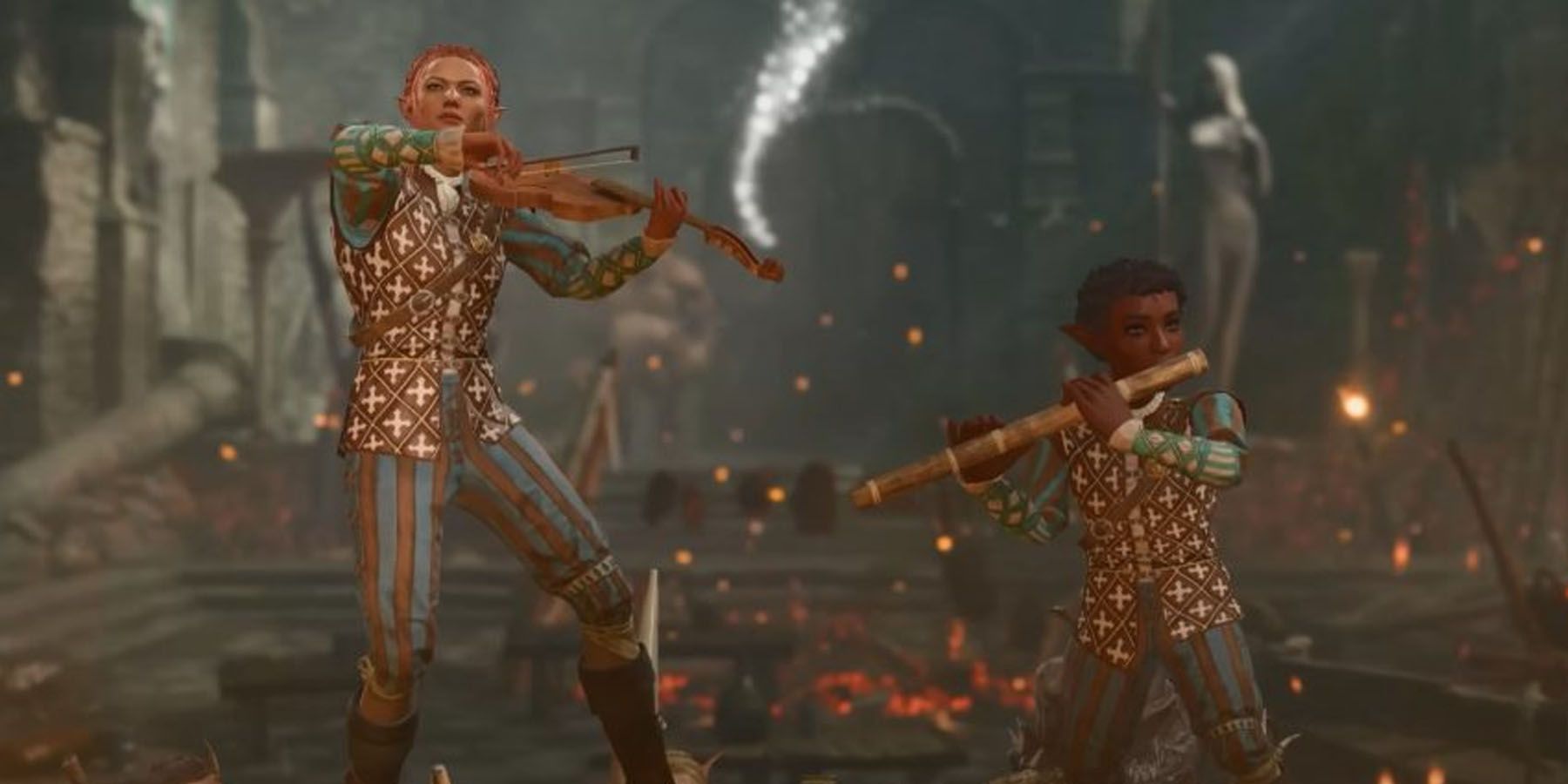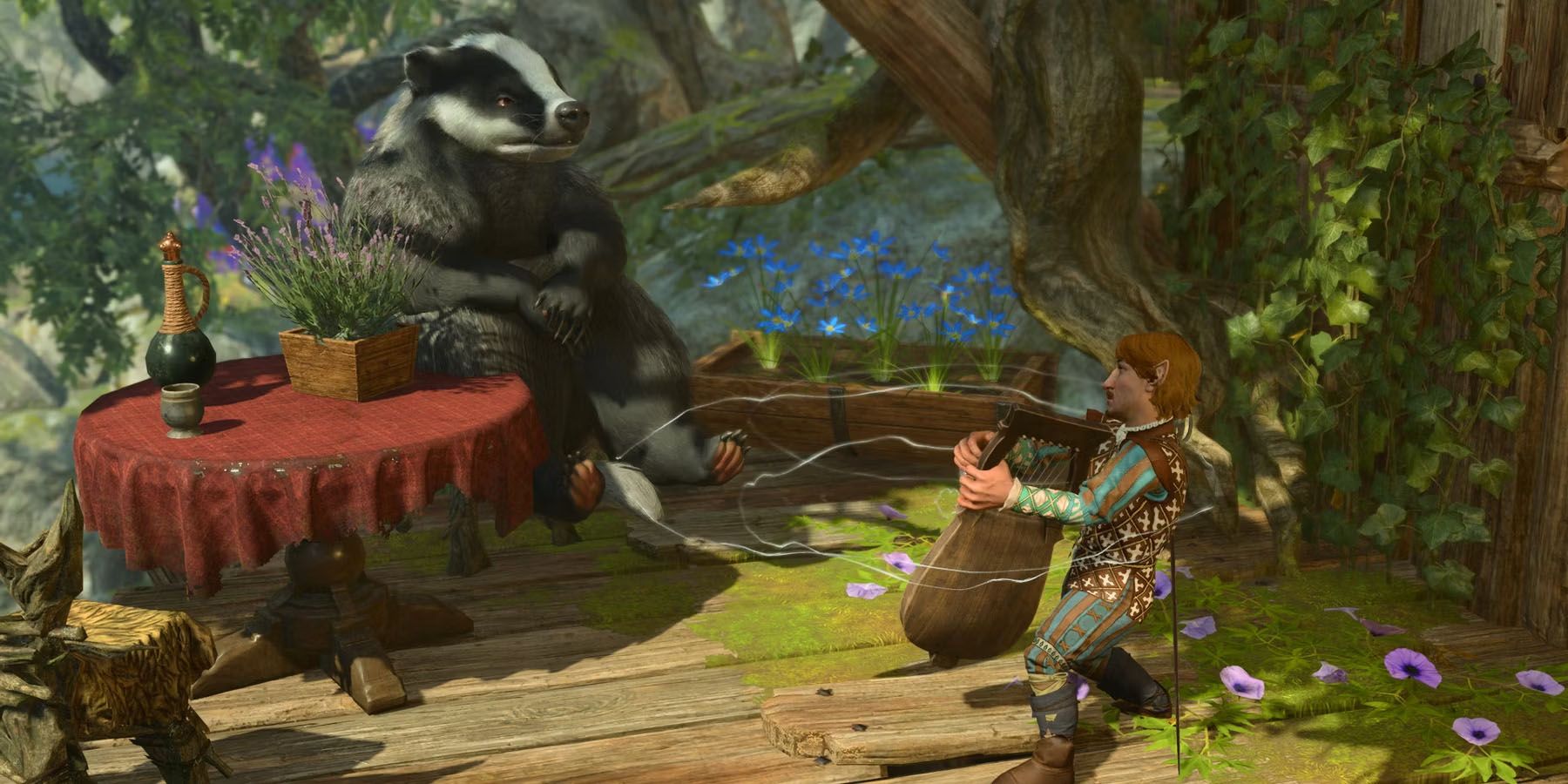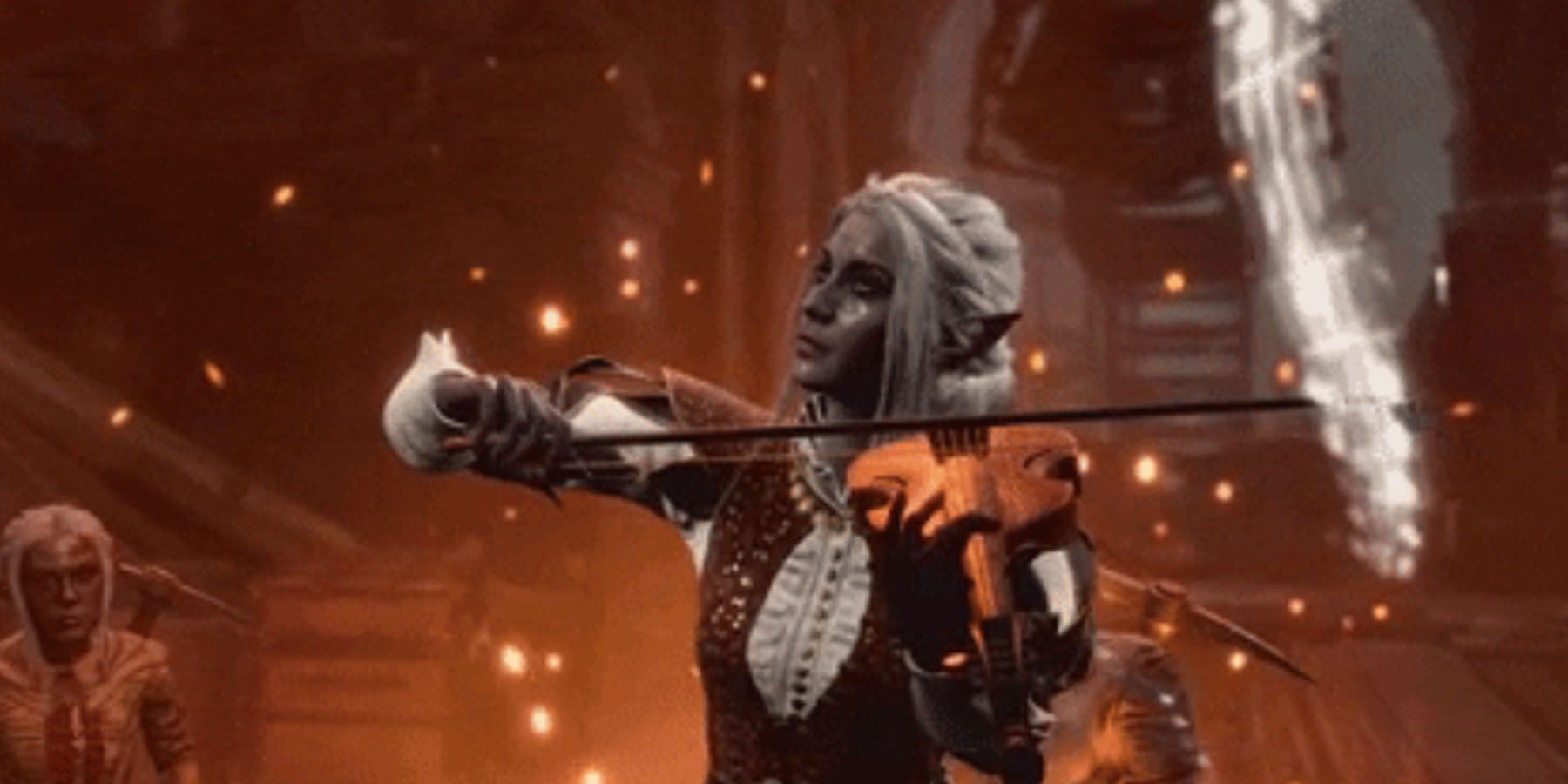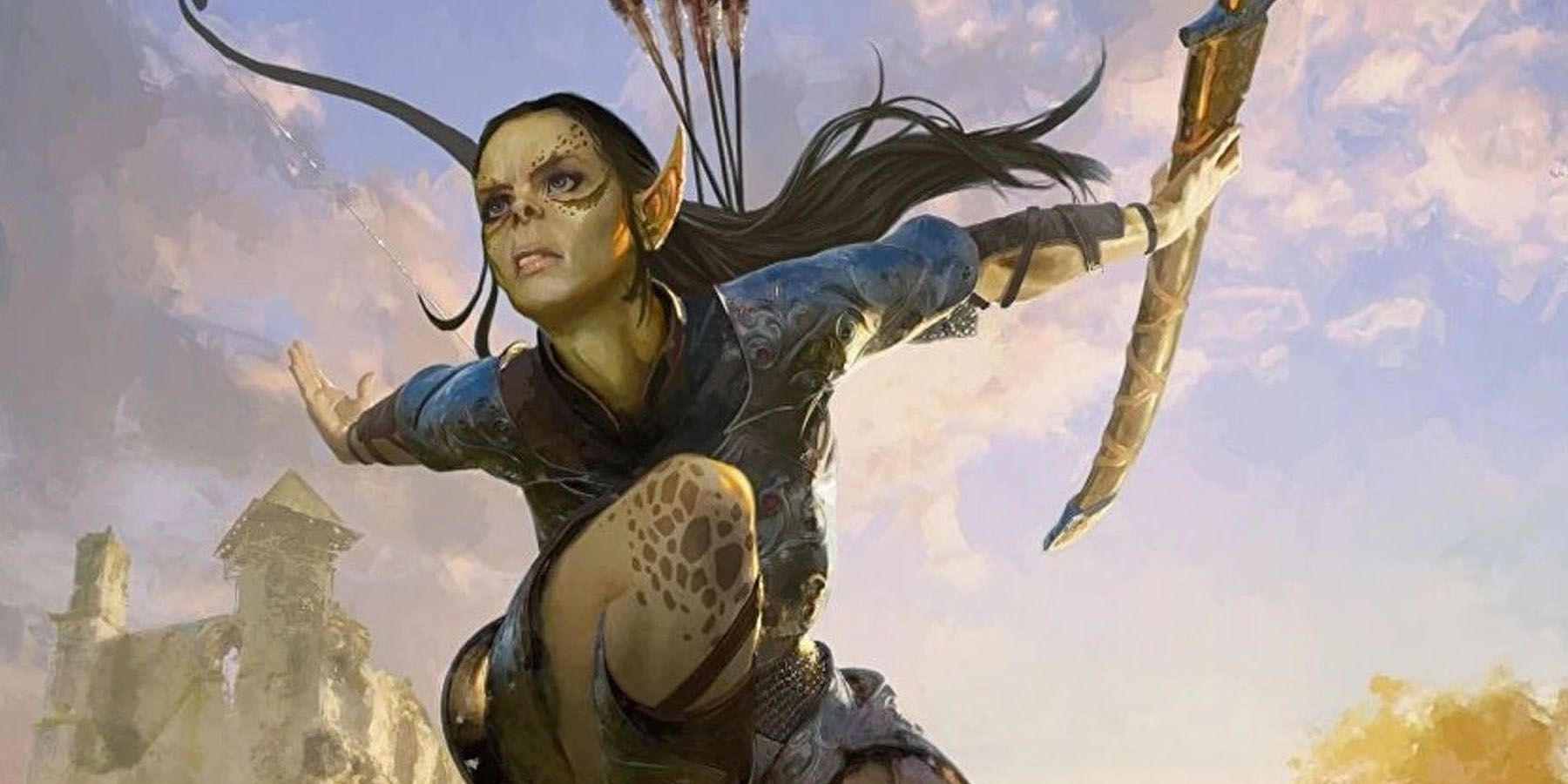Quick Links
Players of classic CRPGs know the sheer intensity of the storylines in the Baldur’s Gate series, making Baldur’s Gate 3 a much-awaited sequel for fans of narrative-focused games. This time around, players of the Baldur’s Gate title get stuck in the middle of an ongoing mind-flayer invasion of Faerun, with only their chosen Class and skillset as a means to fight this seemingly-insurmountable threat.
Players who want to pull off the characteristic Bard from Dungeons & Dragons might want to tailor their Baldur’s Gate 3 Bard to achieve maximum performance and look into possible optimization options for their character. However, just how could players pull off the perfect Bard?
Updated August 4, 2023 by Erik Petrovich: With the full release of Baldur's Gate 3 a lot of things have changed from the Early Access version. Thanks to the new subclasses and expanded maximum level, players' ideas about the best Bard build in BG3 have changed, and will very likely continue to evolve as fans get deeper into the game. This guide has been updated to be accurate to the full release version of Baldur's Gate 3, but it doesn't recommend build choices past Level 4. Check back regularly for more advice on how to make the best Bard build as the Baldur's Gate 3 community continues to learn more about how the class plays at higher levels.
As a guide-in-progress, this build will be continually updated with more information about choices in the mid to late game as players make their way through the expansive Baldur's Gate 3.
The Point Of The Bard
Players of the Baldur’s Gate game who aren’t familiar with its original sourcebook Dungeons & Dragons 5e might not be entirely sure what to expect from the Bard Class. Considered one of the starting Classes in D&D 5e, the Bard serves as a staple character build for players looking for a decent mix between a utility and combat character. Although usually joked around as a promiscuous archetype due to their incredibly-high Charisma, here are other reasons why a Bard may be a player’s go-to Class:
- Bardic Inspiration: As the Class’s most unique feature, Bardic Inspiration is a massive buff that Bards can give their allies, allowing them to add extra dice to any d20-based roll. This value increases as Bards level up.
- Abilities: Charisma and Dexterity, wherein CHA allows players to cast powerful spells and utilities to play with the battlefield while having enough DEX to dish out decent damage in weapon combat.
- Spellcasting: Using CHA as their Spellcasting Modifier, Bards may be able to cast Spells that allow the party to gain various advantages in combat while making interactions outside fighting a breeze.
- Subclass - College of Lore: Serving as the more scholarly specialization of Bards, the College of Lore gives Bards more access to utility spells that serve to aid allies more effectively in combat.
- Subclass - College of Valor: Serving as the combat-based specialization of the Bards, the College of Valor gives Bards access to more offensive-leaning abilities that enable them to become frontline attackers.
The Bard Basics
Before players create the best Bard build possible in the playable version of the Baldur’s Gate title, it helps to understand what they will receive on the get-go as soon as they choose the Bard as a starting Class. Often, these traits become the target of optimization options when creating a min-maxed Bard build for players to enjoy. Here are things players can expect when they create a Bard in the game:
- Starting Instrument
- Players can select an instrument from various musical implements as Bard’s tool. This simply changes the overall sounds of the game when casting Spells and can be changed by switching to another instrument.
- Saving Throw Proficiencies: Dexterity, Charisma
- Players add their Dexterity and Charisma Proficiency Bonuses to their Saving Throws, making Bards more capable of dodging deadly attacks (Acrobatics) or even resisting truth-telling Zone of Truth Spells.
- Proficiency, Light Armor
- Thanks to this proficiency, Bards won’t impose attack disadvantages or prevent spellcasting even when wearing Light Armor.
- Proficiency, Weapons (Simple, Hand Crossbow, Longsword, Rapier, Shortsword)
- These proficiencies allow the Bard to add their Proficiency Bonus when making Attack Rolls, increasing their odds of hitting foes.
The Race: Guarantee Spellcasting
As with most builds that focus on creating ideal Classes, the best Races are often the ones that maximize the boosts players can give to a particular Ability Score. Being a Charisma-heavy Class, the Bard needs to pack a lot of Charisma to ensure they can cast their most formidable Spells successfully. Thankfully, certain Races available to parties in the Baldur’s Gate title can help players maximize their Bard’s performance in the thick of battle:
- Wood Half-Elf: Traditionally, Wood Half-Elves retreat to quiet lives in the forests of Faerun. For the Wood Half-Elf, their half-heritage drives them to continue journeying across the rest of the Realms. As Half-Elves, they give Bards the Fleet of Foot (walking speed becomes 10.5m) and Mask of the Wild (Stealth Proficiency), making the Wood Half-Elf Bard ideal for long-ranged builds.
- Drow: Although relatively unknown due to their lives underground, the Drow are infamously known for worshipping Lolth. However, this is only true for their Lolth-Sworn variants, as Seladrine Drows hope to break away from their association with the dark deity. As Drow, players gain Fey Ancestry, which gives them an Advantage when saving against being Charmed and immunity to sleep, alongside Superior Darkvision (see in the dark within 24m). Even without light, their Dancing Lights (Evocation Cantrip) can illuminate a 12m-radius area. Most importantly, they also gain Proficiency (Rapier, Shortsword, Hand Crossbow). Thanks to proficiency in D&D Versatile Weapons alone, the Drow is ideal for maximizing a Bard’s potential arsenal.
- Human: Being the most common Race in Faerun, Humans are found building lives almost anywhere. What they lack for racial features, they compensate for by getting an extra skill to be proficient with. Because Bards are already so great at skill checks, this just further guarantees success in dialogue. Humans are an ideal Race for a “balanced” Bard build.
The Background: Emphasize On Charisma
While the Bard in Baldur’s Gate 3 specializes in both Dexterity and Charisma, it still follows its original Dungeons & Dragon counterpart that emphasizes Charisma for its combat advantage. Most especially, they need Charisma to be able to impress or intimidate their way past foes, which are Skills that these Backgrounds transform into proficiencies:
- Criminal (Deception, Stealth): An expert in breaking the law and getting away with it, Criminals are more than able to slip into the shadows when needed. Their Deception Proficiency allows them to lie without much consequence, while Stealth allows them to blend into shadows more efficiently, perfect for surprise attacks. This is the ideal Background for offensive, stealth-heavy builds.
- Guild Artisan (Insight, Persuasion): Their skill in their trade makes the Guild Artisan an expert in niche topics, perfect for a Dungeons & Dragons build centered around the traveling craftsman. Their Insight Proficiency lets them gleam knowledge on things they notice, while their Persuasion Proficiency lets them convince others to lean over their side. This is the ideal Background for talking-heavy builds.
- Soldier (Athletics, Intimidation): Trained in various battlefield strategies, the Soldier is both brave and smart in the heat of battle. Their Athletics Proficiency allows them to perform incredible feats of strength, while Intimidation allows them to scare people into submission.
- Charlatan (Deception, Sleight of Hand): Possessing a special knack for twisting their words, Charlatans can make allies turn on each other for profit and amusement. Their Deception Proficiency allows them to fool others, while Sleight of Hand makes thieving easier.
- Noble (History, Persuasion): Being raised in a prominent family, the Noble prioritizes acquiring loyalty, renown, and power. Their History Proficiency lets them identify interesting pieces of ancient knowledge from various situations, while Persuasion allows them to see others on their side.
The Ability Array: Life Takes Second Priority
As with other RPGs similar to Dungeons & Dragons, it makes sense for Baldur’s Gate 3 players to want to prioritize an Ability Array that focuses on the Bard’s greatest strengths: that being Charisma and Dexterity. With the above considerations taken into account, here is an ideal setup for an Ability Array that maximizes the Bard’s performance in the early game:
- Strength 12 (+1): In worst-case scenarios, Strength could become a Bard’s combat Ability, especially for melee builds. However, given how Strength contributes towards Encumbrance, this should also be considered.
- Dexterity 14 (+2): As the Bard’s primary combat Ability, Dexterity should take a secondary or tertiary priority. Ranged Bard builds will use DEX for long-ranged weapons, while DEX could also substitute for STR for Versatile weapons, which also count towards the Bard’s specialization.
- Constitution 16 (+3): As the game’s primary determinant of Hit Points, Constitution should become paramount for the support-based Bard. CON should be equal to or as close to CHA as possible regarding stat distribution.
- Intelligence 8 (-1): Considering how there are not many things Bards do that need INT that the resident spellcaster doesn’t cover, Intelligence could become a dump stat.
- Wisdom 10 (0): Seeing how there are not many things in-game that require a WIS Save or an active WIS Check from the Bard, Wisdom could become a neutral stat.
- Charisma 16 (+3): The bread and butter of the Bard’s build, it’s important they get as high Charisma as possible to maximize the output of their D&D Spells.
Level 1: Pursue Basic Survivability
When players build their Bards for their initial Baldur’s Gate 3 playthrough, it’s ideal they do so from the perspective of optimizing their combat capabilities. Level 2 might be just around the horizon, but it’s best for the Level 1 Bard to build to be as effective in combat as reasonably possible, with the occasional support Spells. It’s imperative that the Bard be built as a secondary attacker, so its healing can come as either a primary role or a substitute to the Cleric. Here are other things players need to consider:
- Bardic Inspiration (Class Feature): Thanks to this Action, a target ally can add a +1d6 bonus to any d20 roll until the next Long Rest. These include Attack Rolls, Ability Checks, and Saves. Ideally, the Bard gives Bardic Inspiration to everyone as soon as possible, as this can become a lifesaver in emergencies.
- Vicious Mockery (Cantrip): This Enchantment Cantrip deals 1d4 Psychic Damage to a target and forces it to get a Disadvantage on its next Attack Roll. As such, this Cantrip becomes a great debuff against tougher foes.
- True Strike (Cantrip): This Divination Cantrip gives players an Advantage on Attack Rolls against the target. As this lasts two (2) turns on Concentration, this is an ideal attacking buff for almost-guaranteed strikes from Ranged Weapons.
- Dissonant Whispers (Level 1): This Enchantment Spell not only forces a target to take 4d6 Psychic Damage on success, but they become Frightened as well. The target successfully doing a Wisdom Save means they take half damage, but 2d6 is still a formidable attack against tougher foes.
- Blade Ward (Level 1): This Abjuration Spell grants the user Resistances to Bludgeoning, Piercing, and Slashing damage from weapons, halving their damage to the user.
- Heroism (Level 1): This Enchantment Spell not only grants an ally up to 5 Temporary HP but also ensures they don’t get Frightened for as long as ten (10) turns. Instead of relying heavily on healing, a guaranteed maximum HP boost via Temporary HP can drastically increase the odds of survival of its user.
- Healing Word (Level 1): This Evocation Spell only heals for 1d4+CHA Mod Hit Points, but this becomes a nifty emergency heal due to its nature as a Bonus Action.
Level 2: Grab Some More Healing
By the time Bards reach Level 2, they receive myriad bonuses that further define their role as the Dungeon & Dragons party’s default “face” or sweet-talker. Whereas Level 1 prioritized Bard’s survivability, Level 2 guaranteed their efficiency inside and outside combat, particularly with regard to healing capabilities in the D&D title. Here are certain things to consider:
- Jack of All Trades (Class Feature): This allows players to add half their Proficiency Bonus (rounded down) to non-Proficient Skills checks. This cements Bard’s ability to sweet-talk or bluff their way into success.
- Song of Rest (Class Feature): When not in combat, a Bard grants the effects of a Short Rest to their allies.
- Cure Wounds (Free Spell/Spell Replacement, Level 1): This Evocation Spell is priority number one for healers, as this touch-based Spell grants 1d8+CHA Mod Hit Points. Players can either take this as an extra Spell if they’re pursuing a healing route or replace Heroism with this via Spell Replacement.
- Tasha’s Hideous Laughter (Free Spell/Spell Replacement, Level 1): This Enchantment Spell forces a target to become Prone and Incapacitated, essentially leaving them as targets for the rest of the party to attack without fear of retaliation. They can get Tasha’s as a free Spell or replace Heroism with this Spell via Spell Replacement.
Level 3: Cement Healing Specialization, Prioritize Combat Role
Unlike other Classes in Dungeons & Dragons, the Bard of Baldur’s Gate 3 cannot pick a subclass or an archetype until Level 3. This time called a Bard College practically “cements” the Bard’s specialization throughout the game. Depending on the player’s choice of role, the Bard may be tailored to become a healer via the College of Lore or a combat expert via the College of Valor. Here are things to take note of:
College Of Lore: Outside Battle Matters Too
Bards who choose the College of Lore value knowledge and truth more than anything else and spend the rest of their days collecting wisdom and lore wherever they see it. They don’t care much about combat but rather relish in the pursuit of information. Support builds can rely on the College of Lore Bard for outside-combat maneuverability, especially with their additional Proficiencies. Here are other things to take note of:
- Cutting Words (Class Feature): With this ability, the Bard can force a 1d6 penalty toward Attack Roles, Ability Checks, and Damage Rolls to an opponent until the beginning of their next turn. Think of this as a negative Bardic Inspiration designed to debilitate the enemy’s combat performance.
- Arcana, Intimidation, Sleight of Hand (Proficiency): The Bard also gains proficiency in Arcana (INT), Intimidation (CHA), and Sleight of Hand (DEX), cementing their potential role outside combat. With Arcana, Bards are also likely to be able to access arcane knowledge in the absence of a spellcaster. Meanwhile, Sleight of Hand can transform the Bard into a miniature Rogue to steal items, whereas Intimidation gives the party a better shot at forcing enemies to submit through fear.
College Of Valor: Cementing Offense
Players who want their Bard to capitalize on their combat potential may want to choose the College of Valor. This College trains their Bards to keep an eye out on heroes around them, ensuring they stay alive to tell their tales - meaning they have to train to become the heroes they idolize. Players should choose the College of Valor if they want to perform better in combat, particularly at close range. Here are things to note:
- Combat Inspiration: An upgraded form of Bardic Inspiration, the affected creature can now add the +1d6 bonus to their Damage Roll or use it to get +4 AC against one attack, allowing them to bolster the attack power or defensive capabilities of their allies.
- Medium Armor (Proficiency): Bards now get an upgrade regarding defense, as wearing Medium Armor no longer prevents them from casting Spells nor will it penalize Attack Rolls, perfect for Bards with a penchant for Melee Weapons.
- Shields (Proficiency): Bards can now equip a Shield without penalizing their Attack Rolls and Spellcasting capabilities.
- Martial Weapon (Proficiency): Bards can now equip more complex weaponry, making them more in tune with Fighters regarding base damage potential.
Level 4: Optimize Combat Routine
By the time players reach Level 4, they will likely have a “set routine” for their Bard when in combat. This Level makes it the perfect time for Bards to capitalize on these routines and optimize them further to ensure their spotless performance, especially since they most likely moonlight as a support unit. In that regard, here are things to consider:
- +2 CHA (Ability Score Improvement): While players can also select a Feat, it’s ideal for a Bard to at least maximize their CHA whenever possible to strengthen their Spellcasting capabilities. In this case, a +2 to their CHA Score could be an invaluable asset in the long haul, especially when using more powerful Spells.
- Mage Hand (Cantrip): Players having a tough time reaching far objects may want the Bard to have Mage Hand, allowing them to interact with objects from as far as 18m. This is a nifty way of removing some pressure away from the Wizard so they can focus on more combat-oriented Spells. Level 4 may be a long time to wait to grab Mage Hand, but players by now have been oriented with the game’s mechanics that Mage Hand is a nifty way to start “breaking” the rules to their benefit.
- Enhance Ability (Free Spell/Spell Replacement, Level 2): This Transmutation Spell can grant one of the various mystical enchantments to an ally, which until the end of the Spell gives Advantage to one (1) Ability Check and an extra perk (+7 Temp HP for CON, double carry capacity for STR, half fall damage for DEX).
- Lesser Restoration (Free Spell/Spell Replacement, Level 2): This Abjuration Spell allows the caster to remove one condition or disease afflicting one creature, allowing the Bard to cement their support role.
- Crown of Madness (Free Spell/Spell Replacement, Level 2): This Enchantment will make its target mad with fear and anger, forcing it to attack creatures close to them regardless of their allegiance.
- Shatter (Free Spell/Spell Replacement, Level 2): This Evocation Spell deals as much as 3d8 Thunder damage to objects and creatures. While a successful Saving Throw means the target takes half damage, creatures of inorganic materials like stone get Disadvantage when doing them.
Baldur’s Gate 3 is available on PC and will release on PlayStation 5 on September 6, 2023.












